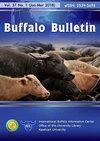CIDR方案对受RFM影响和正常产犊水牛受孕率的影响
IF 0.2
4区 农林科学
Q4 AGRICULTURE, DAIRY & ANIMAL SCIENCE
引用次数: 0
摘要
产后卵巢周期性恢复延迟会导致水牛产犊间隔时间延长。产后疾病尤其是胎膜残留(RFM)的发生进一步延长了这一间隔时间,进而给养殖社区造成严重的经济损失。我们挑选了产后 45 至 60 天的 16 头水牛,包括 8 头接受胎膜残留治疗的水牛和 8 头正常产犊的水牛,用阿苯达唑口服驱虫药,并在驱虫后 15 天内口服 50 克矿物质混合物。在所有产后 60 至 75 天的水牛阴道内插入 CIDR,并在原位放置 9 天。在取出 CIDR 前 24 小时,所有水牛都接受了 500 µg PGF2α 肌肉注射。在 CIDR 撤除后的 48 小时(第一次人工授精)和 72 小时(第二次人工授精),对水牛进行人工授精。在人工授精后 60 天,通过直肠检查进行妊娠诊断。CIDR 从插入到拔出的保留率为 100%。通过超声波检查评估,NC 和 RFM 受影响水牛发情诱导后的排卵反应百分比分别为 100%和 87.50%。两组水牛的血清平均孕酮水平从选择到注射 PGF2α 期间均有所上升,但在第一次人工授精时,血清孕酮水平低于 0.5 ng/ml,而在人工授精后 10 天,两组水牛的孕酮水平均有所升高。血清雌二醇水平从选择动物到第一次人工授精期间一直在上升,然后在人工授精后 10 天下降。与受 RFM 影响的水牛相比,在所有组别中,NC 水牛从选择动物到第一次人工授精的平均血清雌二醇水平都较高。由此得出结论,在田间条件下,用 CIDR 加 PGF2α 诱导发情,并事先驱虫和补充矿物质混合物,可用于产后 NC 或 RFM 受影响水牛,以达到最高受孕率。本文章由计算机程序翻译,如有差异,请以英文原文为准。
Effect of CIDR protocol on conception rate in RFM affected and normally calved buffaloes
Delayed re-establishment of ovarian cyclicity after parturition leads to increased inter-calving interval in buffaloes. This interval is further extended by the occurrence of post-partum disorders especially retained fetal membranes (RFM) which in turn causes heavy economic loss to the farming community. A total of 16 buffaloes at 45 to 60 days post-partum period including 8 buffaloes treated for retained fetal membranes (RFM) and 8 normally calved (NC) were selected and dewormed orally with Albendazole and administered orally with 50 g mineral mixture for 15 days after deworming. All the buffaloes at 60 to 75 days post-partum were inserted with CIDR intravaginally and left in situ for 9 days. All the buffaloes received an intra-muscular injection of 500 µg PGF2α at 24 h prior to CIDR withdrawal. At 48 (first AI) and 72 h (second AI) of CIDR removal, the buffaloes were artificially inseminated. Further, those buffaloes which failed to conceive and returned to oestrus (subsequent oestrus) following breeding at induced oestrus, were artificially inseminated twice at an interval of 24 h. Pregnancy diagnosis was done by rectal examination at 60 days post-insemination. Retention rate of CIDR from insertion to withdrawal was 100%. The percentage of ovulatory response assessed by ultrasonography following oestrus induction in NC and RFM affected buffaloes was 100 and 87.50%. The first service, second service and overall conception rates were 25, 37.50 and 62.50 and 62.50, 25 and 87.50 in RFM and NC groups respectively.In both the groups, the serum mean progesterone levels increased from the time of selection to the time of PGF2α injection but at first AI, the serum progesterone levels reached below 0.5 ng/ml and at 10 days post AI, there was an elevated progesterone levels in both the groups. The serum oestradiol levels increased from the time selection of animals to the time of first AI and then declined at 10 days post AI. The mean serum oestradiol levels were higher in NC buffaloes from the time of selection of animal to first AI in all the groups when compared to RFM affected buffaloes. It is concluded that oestrus induction with CIDR plus PGF2α with prior deworming and mineral mixture supplementation could be used in post-partum NC or RFM affected buffaloes to achieve maximum conception rate under field conditions.
求助全文
通过发布文献求助,成功后即可免费获取论文全文。
去求助
来源期刊

Buffalo Bulletin
AGRICULTURE, DAIRY & ANIMAL SCIENCE-
CiteScore
0.50
自引率
0.00%
发文量
53
审稿时长
>12 weeks
期刊介绍:
Buffalo Bulletin is published quarterly in January-March, April-June, July-September and October-December. Contributions on any aspect of research or development, progress reports of projects and news on buffalo will be considered for publication in the bulletin.
 求助内容:
求助内容: 应助结果提醒方式:
应助结果提醒方式:


